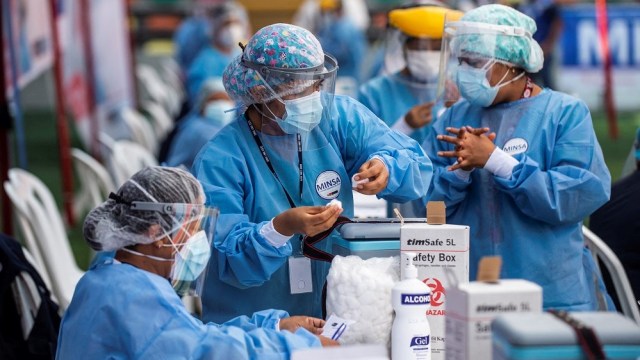
The COVID-19 pandemic has created multiple opportunities for the People’s Republic of China to advance its commercial position and influence in Latin America and the Caribbean.
By Diálogo – Digital Military Magazine – R. Evan Ellis
Jul 29, 2021
The most significant, in the short term, has been China’s vaccine diplomacy. Over a million people in the region have died from COVID-19 since the virus was first detected in the region in February 2020. That death count, according to the Pan American Health Organization, is about 75 percent more than in the United States, which has registered a similar number of infections.
Moreover, while the United States has inoculated over 62 percent of its adult population, bringing infection rates dramatically down and allowing it to begin to reopen its economy, the end of the struggle is nowhere in sight for Latin America, where variants of the virus are driving new waves of infection and forcing new economic shutdowns in countries from Colombia to Trinidad and Tobago.
In the context of the region’s urgent need for vaccines to combat the pandemic, a perfect storm of unintended effects from U.S. policy decisions, the dynamics of international vaccine contracts and prioritization, and China pursuing strategic and business opportunities, has given rise to a widespread and dangerous – albeit erroneous – perception that Beijing is coming to the rescue of the region with its vaccines while America focuses exclusively on its own population.
From the beginning of the vaccine rollout, the United States pursued a strategy of attending to the needs of its own population through direct vaccine contracts with major pharmaceutical manufacturers, while simultaneously contributing generously to the World Health Organization’s Covax initiative to help other nations obtain the vaccine they needed. Covax, by design, deliberately deemphasizes the identity of donors and focuses on equitable distribution of vaccines of demonstrated quality.
The $4 billion U.S. commitment to Covax is far greater than that of any other international donor or group, including the European Union and the United Kingdom, with neither China nor Russia even making the list.
Unfortunately, the massive, urgent demand for vaccines, logistics difficulties, and – ironically – the need by Western pharmaceutical firms to prioritize contracts they had with the U.S. government, has to date limited the number of vaccines reaching the region through the Covax effort. At the same time, the nature of Covax suppressed the region’s understanding of the role of U.S. generosity for the 76 million Covax doses already distributed globally, according to the organization.
Meanwhile, driven in part by the need for ethnic diversity in vaccine testing, Chinese companies such as Sinovac and Sinopharm conducted phase II and III clinical trials in multiple Latin American countries including Peru, Brazil and Argentina. This created the basis for the subsequent rapid certification and distribution of Chinese vaccines there.
Moreover, China’s relative control of COVID-19 at home – by contrast to the grave situation in other nations – and the ability of Chinese companies to ramp up vaccine production, set the stage for Beijing to dramatically expand exports of its vaccines to countries in need in Latin America and elsewhere. It is currently providing its vaccines to at least 12 Latin American and Caribbean countries.
According to the Pan American Health Organization, as of the end of May, Chinese-made vaccines accounted for 82 percent of all doses administered in Chile, 86 percent in El Salvador, and 32 percent in Peru.
The May receipt of 1.3 million Chinese vaccine doses by Venezuela, already reliant primarily on Chinese and Russian vaccines, promises to deepen the Maduro regime’s dependence on China as well.
The Chinese government, with the collaboration of its Latin American partners, has extended the impact of its vaccine diplomacy by making every vaccine delivery a photo op, with boxes of Chinese vaccines emblazoned with Chinese markings unloaded from aircraft in front of assembled reporters, often with the president of the recipient country or other senior officials present.
Vaccine diplomacy highlights China’s disposition in a broad range of areas to capitalize on the needs and hopes of the region to advance its economic and other interests. Despite the impression often given by China, the majority of Chinese vaccines are sold to the region, not donated, in contrast to the generous U.S. $4 billion contribution to Covax, or those of other developed countries in Europe and Asia.
In the early days of its vaccine campaign, China offered a $1 billion loan fund to facilitate Latin American purchases of exclusively Chinese vaccines, in the same way that its policy banks provide loans that help Latin American governments buy Chinese products and services in other areas.
The nation also used vaccine diplomacy to advance political and other strategic objectives. Both Brazil and the Dominican Republic reversed prior commitments to exclude the Chinese vendor Huawei from their nations’ 5G networks, after receiving Chinese commitments to deliver their vaccines.
…
Read More: Diálogo – Digital Military Magazine – Vaccine diplomacy in Latin America, Caribbean a PR Coup for China
…

